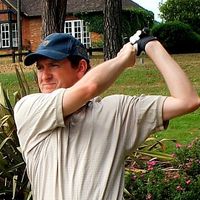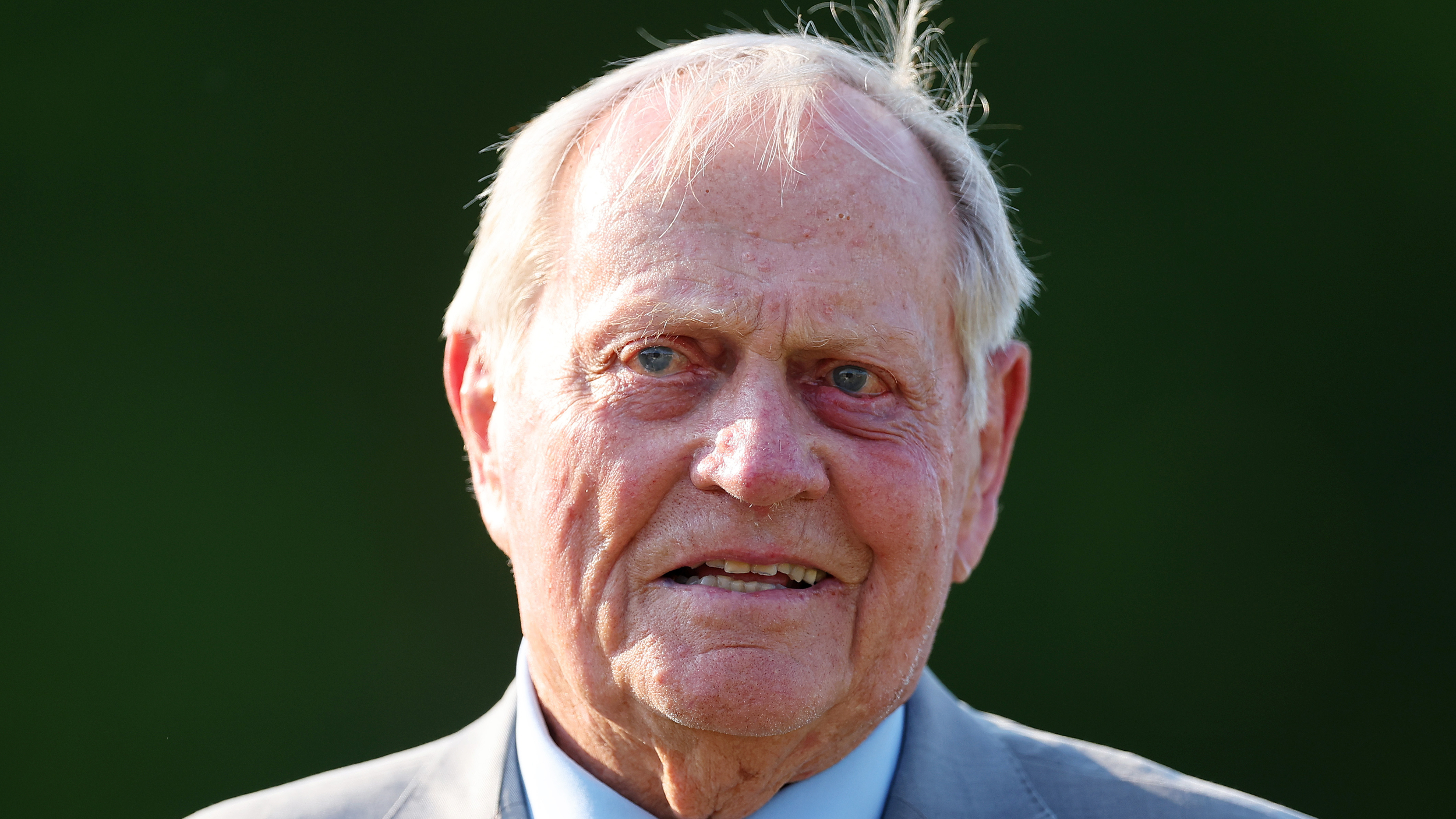
Twenty-year old amateur, Nick Dunlap, carded a tournament record 72-hole score of -29 to become the first amateur to win a PGA Tour event since Phil Mickelson at the 1991 Northern Telecom Open.
Dunlap won by a shot after a final day in which sometimes he was in the solo lead, sometimes Sam Burns was — and sometimes there were joint leaders, with Kevin Yu making it a three-way tie at the head of the leaderboard at one stage. Yu had come from nine shots back and went round in 63, a bogey on 18 falling him back to tied for third.
Dunlap had maintained his overnight three-shot lead until the seventh, where he found water and made a double bogey, with Burns pouncing to seize the joint leadership of the tournament with a birdie.
Burns and Dunlap were level coming to the 17th hole, the notorious Alcatraz island hole par-3. Dunlap played first and found the front of the green; Burns found water. Dunlap made par there and had a two-shot lead walking to the 18th tee, which soon became a one-shot lead when up ahead of them Christiaan Bezuidenhout birdied the 72nd hole.
Dunlap was able to survive a wayward tee shot, though, and was left with a 5ft 9in putt for par on 18 and the championship. He becomes only the fifth amateur in the past 70 years to have won on PGA Tour. As well as him and Phil Mickelson, the others are Scott Verplank (1985 Western Open), Doug Sanders (1956 Canadian Open) and Gene Littler (1954 San Diego Open).
The American Express Final Leaderboard
- -29 Dunlap (a)
- -28 Bezuidenhout
- -27 Schauffele, Yu, Thomas
- -25 Burns, Kim, Hadwin
The American Express Quick Links
Updates from...

Welcome
Welcome to our live coverage of the final day of The American Express Championship where all eyes are on U.S. Amateur champion Nick Dunlap. He is playing on this event on a sponsor’s invite and was the overnight leader by three shots coming into today.
The last amateur to win a PGA Tour event was Phil Mickelson, in 1991 at the Northern Telecom Open. Only four amateurs in the past 70 years have won on PGA Tour. The others are Scott Verplank (1985 Western Open), Doug Sanders (1956 Canadian Open) and Gene Littler (1954 San Diego Open).
Amateur winners of events open to pros used to be more common and many of the early greats of the game were amateurs, including winners of The Open Championship and the U.S. Open. In the early days of national golf competitions, the golf professional was viewed as a lowly fellow, a club servant, and the prize money for winning golf events was not munificent. So anyone who considered themselves a “gentleman” tended to shy away from becoming a professional golfer. This, after all, was in the days when professional golfers were normally not allowed in the clubhouse.
Dunlap is 20 years and 29 days old, which would make him one of the youngest winners of a PGA Tour event. But not the youngest. Since 1900 there have been five teenage winners. The youngest of whom was another amateur golfer Charles Kocsis, who won the Michigan Open in 1931 when he was 18 years, 6 months and 9 days old. The most recent teenager to win was Jordan Spieth, at the 2013 John Deere Classic.
Nick Dunlap is due to start his final round in about a quarter of an hour.
The format
The first three days involved players playing a round at each of three courses – La Quinta Country Club and Pete Dye Stadium Course and Nicklaus Tournament Course which are both at PGA West – and then a cut was made. The final round is now being played over the Pete Dye Stadium Course.
What happens to the prize money and FedEx Cup points if amateur Dunlap wins?
The prize money is for professionals only, so the 1st prize is not technically for the winner of an event but for the professional who does the best - and normally of course they are the same thing. So wherever Dunlap finishes, he is just ignored in the allocation of prize money. Thus, if he wins, the 2nd place person would win the 1st money prize; if Dunlap comes 4th, then 5th gets the 4th money, and 6th the 5th money and so on.
FedEx Cup points are different however. The 500pts for winning are only awarded to someone who actually wins, and so on down the field.
The final group has played the 1st hole
With Dunlap in this group are Sam Burns and Justin Thomas. All three made par.
Griffin rising
Ben Griffin has climbed seven places to T5 after he chipped in for eagle on the 5th having made birdie on the 4th hole.
Final group all record pars on the 2nd hole
Dunlap's birdie putt lacked conviction perhaps but he has made an assured start to the final round.
Wondering who Nick Dunlap is?
If so, you are probably not the only one. My colleague Jonny Leighfield has put together a handy guide 18 Things You Didn't Know About Nick Dunlap
Pars all round on 3rd for leaders
None of the group has got a putt to drop yet. They've not putted badly, just nothing has gone in.
Twenty-five years ago at this tournament PGA history was made
Nick Dunlap missed out by a shot yesterday in becoming only the 13th man to record a sub-60 round on the PGA Tour. This tournament has already seen a 59 carded. It was 25 years ago. David Duval shot a final day 59 to win this tournament. It was only the third time someone had made 59 on the PGA Tour, but Duval was the first to shoot 59 in the final round. Al Geiberger had carded a second round 59 in the 1977 Memphis Classic and Chip Beck a third-round 59 in 1991 Las Vegas Invitational.
Such a score may suggest that Duval holed some long putts, maybe had a chip in or two. But no. He didn’t sink a single putt of over 10ft. But then he rarely needed to. His approach play was fantastic – he hit half of his approach shots to within 5ft. Only three approaches ended more than 20ft away, and he was on 17 of the greens in regulation.
This was part of a purple patch for Duval. He had started 1999 by winning The Sentry by nine shots and the American Express by a single shot. He was 52 under par in his first nine rounds of the year (The American Express was a 90-hole event in those days). When he won the Players Championship in March he went to number one in the world. When he won the Bell South Classic the following week it meant he has won 11 of his most recent 34 tournaments since his debut tour win in October 1997. But Duval was to win only twice more on the PGA Tour – but one of them was the Open Championship in 2001. All of his 13 tour wins came in a 33-month stretch,
Duval is one of 11 golfers to have carded a 59 on the PGA Tour, the most recent of whom was Scottie Scheffler in the 2020 FedExCup playoffs. But Jim Furyk hold the lowest round, with a 58 in the final round of the 2016 Travelers Championship. Furyk only came T5 in this event. Indeed of the dozen golfers who have made sub-60 rounds on the PGA Tour, only five actually won the tournament.
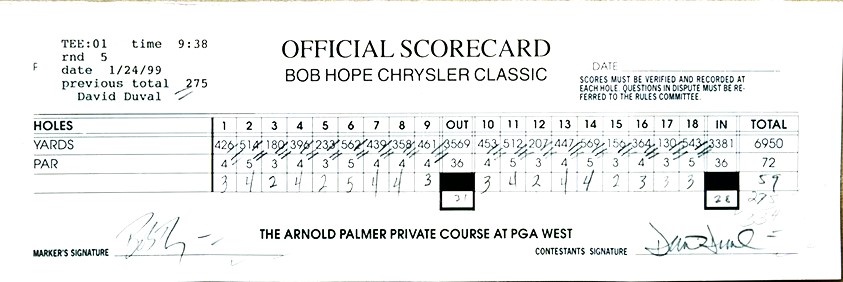
Pars all round for leaders on 4th hole
So far so good for Dunlap. He is maintaining his lead on the second and third--placed golfers.
That chip in by Christiaan Bezuidenhout
An 🦅 chip-in for @BenGriffinGolf.A 👍from @ZachJohnsonPGA. pic.twitter.com/P9y2cxLMx5January 21, 2024
Bezuidenhout up to joint second
He has made birdie on the par-5 5th. It's his third birdie of the round.
Same tournament, different name
If you are wondering why Duval’s scorecard said ‘Bob Hope Chrysler Classic’ on it, this is because this tournament has had several different names during its history. It was founded 1960 as The Palm Springs Golf Classic, and renamed the Bob Hope Desert Classic in 1965 and then then Bob Hope Chrysler Classic in 1986. In 2009 it became the Bob Hope Classic, then in 2012 it became the Humana Challenge, in 2016 the CareerBuilder Challenge and in 2019 it was simply called the Desert Classic. Since 2020 it has been the American Express Championship.
Final group provides a bit of variety on the par-5 5th
Dunlap misses the fairway off the tee, and so has to play his third shot as the approach, but it is dead on and a simple putt for a birdie follows. Burns has an eagle putt from the back of the green, but it sneaks past and so he has to settle for birdie and remains 3 shots off the lead. Thomas drowns his approach shot but rescues par. But JT is now 5 shots off the lead.
Dunlap's approach on 5
A dart from leader Nick Dunlap 🎯The amateur's first birdie of the round moves him to 28-under. pic.twitter.com/u3po9dnhqBJanuary 21, 2024
Past venues
La Quinta Country Club has long been used for this tournament, making it debut in 1964 and barely missing a year since. However the other two courses are more recent additions to the rotation. In all 13 courses have been used over the years, the others beings PGA West Palmer Course (25 times) PGA West Nicklaus Private Course (7), SilverRock Resort (4) Bermuda Dunes (49), Classic Club (3), Indian Wells Country Club Classic Course (46), Tamarisk Country Club (19), Indian Ridge Country Club Grove Course (3), Eldorado Country Club (17), Thunderbird Country Club (3). Unsurprisingly many of these courses feature in our guide to the best golf courses in Palm Springs.
Double bogey for Dunlap
This has opened things up at the top of the leaderboard. Dunlap hit his tee shot into water on the 7th, but Burns snaffles a birdie. They are now the co-leaders. Dunlap's three-shot lead gone on one hole.
Keith Mitchell on the charge
He is nine under par for his round so far after making his second eagle. He has three holes left. He started on the 10th so he has already played the potential card-wrecking 16th, 17th and 18th holes. He is on -23, three shots off the lead.
Dunlap returns to the solo leadership
A birdie on the par-5 8th does it as Burns can only make par. Good bounce back by the 20-year-old amateur after that calamitous 7th hole.
How Dunlap lost that three-shot lead on the 7th
A tie for the lead after this sequence of events. pic.twitter.com/iZ7sqJT8GkJanuary 21, 2024
Ko has done OK
Lydia Ko has won the Hilton Grand Vacations Tournament of Champions, the 27-year-old's 20th win on the LPGA tour.
The course they tried to ban.. and did
The course’s designer Pete Dye has a reputation for designing tough courses. He said that; “Life is not fair, so why should I make a course that is fair.” Dye’s reputation meant that he was the obvious person for developers Ernie Vossler and Joe Walser to employ to build their new layout as they wanted, in their words, “the hardest damn golf course in the world.” They certainly got the hardest course in the United States anyway, for its course rating of 77.1 was the highest ever given by the United States Golf Association.
The course was one of those selected to host the Desert Classic in 1987. It was roundly condemned as unfair test of golf by press and players. Los Angeles Times columnist Jim Murray wrote that “you need a camel, a canoe, a priest and a tourniquet to get through it.” Tom Watson complained that “It requires you to execute shots that no sane golfer should be expected to play.” Raymond Floyd called the design “hateful” and “spiteful”.
The players petitioned to have the course struck off the Desert Classic rota, and it was. It only reappeared as a venue for the Desert Classic in 2016.
The final group is through the turn
Dunlap leads by a shot from Sam Burns and Kevin Yu. Dunlap is level par for the round; Burns is -2 and Yu -8.
Keith Mitchell is the clubhouse leader
He went round in 10 under today and is the clubhouse on -24. He is currently tied 6th.
Yu joins the co-leaders
He started the day nine shots back; now he is level with Dunlap and Burns after making the 9th birdie of his round. He has played 14 holes.
Trouble on 17 for Chris Kirk
He misses the green on the island green 17th and plays off the greenside rocks. His ball ricochets back into the water. He ends up with a 6.
Name of the 17th hole
While on the subject of that 17th hole. What woud you call an island green on a desert course. How about Desert Island? No. Alcatraz. I kinda get it that Alcatraz is a famous local island, especially if you ignore the fact that it is about 500 miles away. But how does a golf green equate more to a notorious prison than a place of refuge? Desert islands are traditionally – I’ve seen films – where the shipwrecked find land and so rescue themselves from drowning. Isn’t this more appropriate for a green surrounded by water, the sole place your ball can end up to avoid it being drowned?
Or, to put it another way when you see this

Do you immediately think this
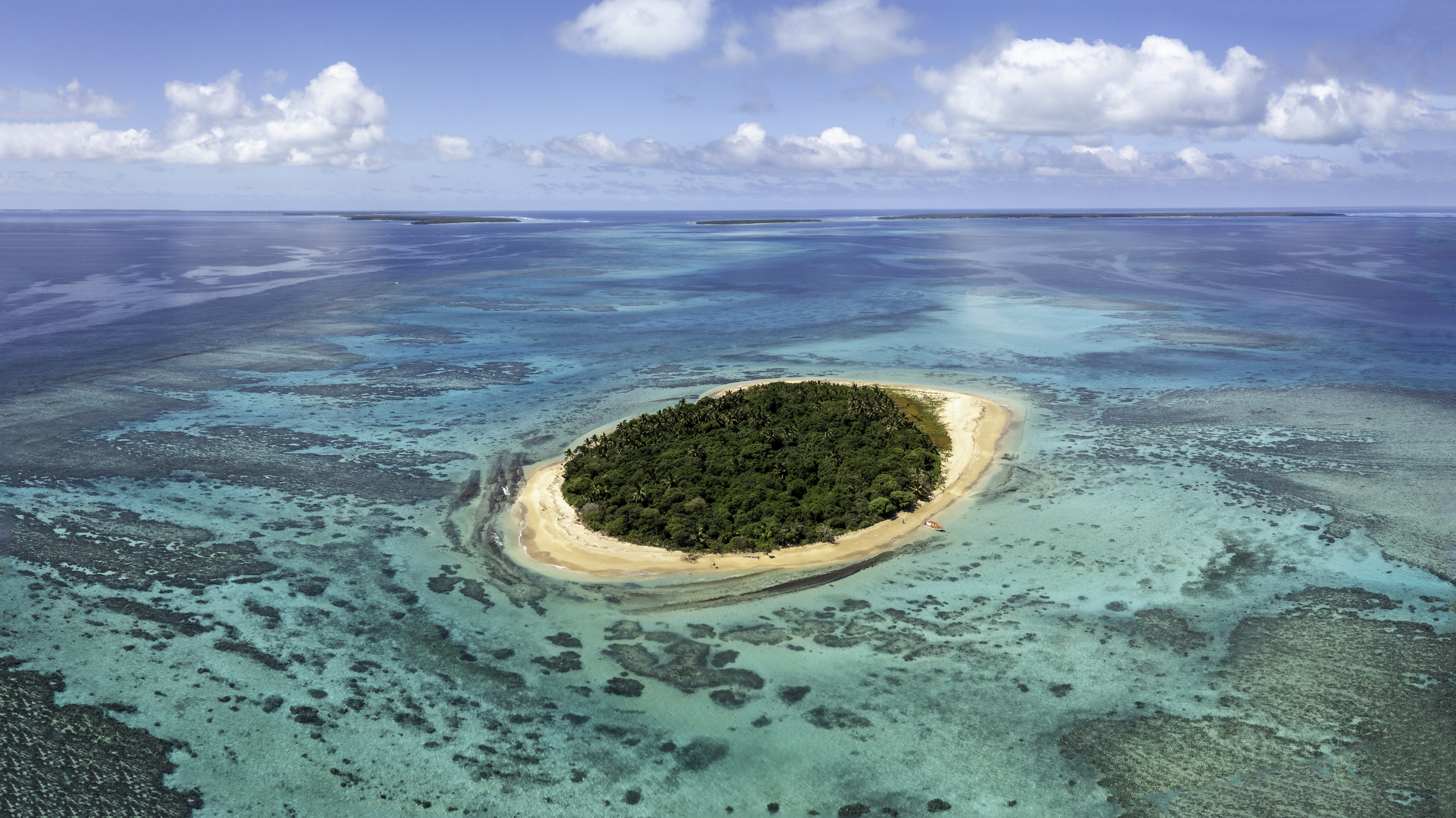
Or this?
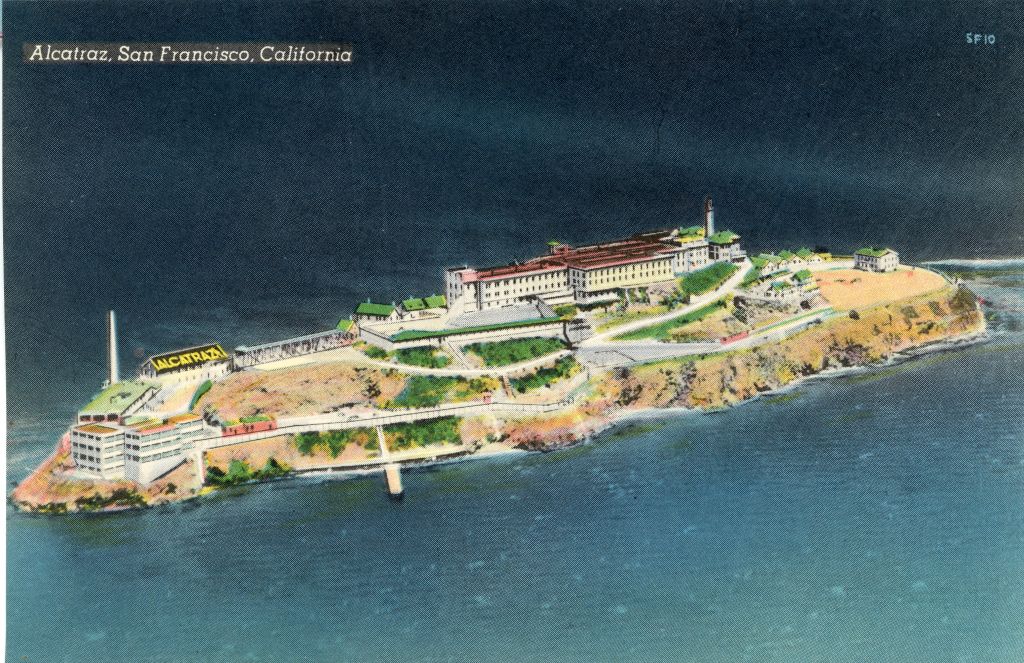
Even odder: that picture of Alcatraz prison is a souvenir postcard from 1947. I know in 1963 Alcatraz stopped being a prison and is now a tourist attraction, but in 1947 it was still a maximum-security prison, Who are the souvenir postcards for? The inmates? “Darling sweetheart having a lovely time, wish you were here”? Or was there a gift shop in the prison for those coming to visits the prisoners? “Dear Crusher, Just been to see Slasher. He’s got a pinched look but otherwise seems fine. His sewing is coming in treat I hear and he has applied to take swimming lessons. See you round the back of the bank 2am next Thursday, Yours Knuckles.”
Yu makes it two at the top
Yet another birdie, this one on the 16th, brings him level with Burns on -28. The lowest 72-hole score for this tournament is -28 incidentally, so the winner may need to break the record.
Bezuidenhout now one back from the co-leaders
His approach from 138 yards on the 478-yard par-4 15th bounces twice on the green and then rolls in.
Birdies on 14 for Burns and Dunlap
So Sam Burns goes into the solo lead.. again. Yu and Dunlap are one shot behind.
Sequel
To many, the Stadium Course at PGA West is seen as architect Pete Dye’s sequel to TPC Sawgrass. The courses certainly shares many characteristics especially down the closing stretch. PGA West finishes with a risk-reward par 5, island-green par 3 and water-lined par 4 – just as TPC Sawgrass does.
Perhaps the most glaring symmetry is in the 17th holes. However there are some differences here in that the island green at Sawgrass is played from a tee level with it, and is smaller than the one at PGA West, reflecting that the hole is also shorter – Sawgrass’ 17th is 137 yards from the tips, PGA West’s 165 yards. Unlike at Sawgrass, PGA West’s 17th tee is also slightly higher than the green.
The island green par-3 17th at Sawgrass was actually the idea of Dye’s wife Alice. The original design had water just on the right-hand side, bit so much earth had been dug out to use elsewhere on the course, the design was going to have to be tweaked. But rather than simply increase the size of the water hazard, she suggested just going the whole hog and turning the hole into an island-green one.
Yu the clubhouse leader
He found a bunker off the 18th tee and can only get on the green on the par-4 435-yard 18th in three and he makes bogey. That sends him into the clubhouse on -27 which will not be enough to win. It's now it's a battle between Burns and Dunlap.
Dunlap misses birdie putt on 15
This after his approach had hit the flagstick. Burns had already made par. Now they come to the final three holes with Burns a shot ahead.
Architect Pete Dye called PGA West’s final three holes “maybe the most difficult finishing holes I’ve ever built.” The 17th is playing as the hardest hole to par; the 18th as the 3rd hardest. The tee has been moved up on the 16th today, so it is playing more benignly than usual and is ranking as the fourth easiest hole.
The wedge shot that rescued the 16th-hole design
The par-5 16th, which the leaders are now playing, has a greenside bunker that is 20ft deep. The exact depth was not pre-determined, Dye just told the bulldozer driver to keep digging until he struck water. “His bulldozer finally found water at 22 feet” Dye wrote, “and we leveled it off at 20.”
Despite telling Dye that he was to create the ‘hardest course in the world’, developer Ernie Vossler thought this was going too far, or too deep anyway. He arranged to have some sand placed down there, and told Dye recalled “Tossing me a sand wedge, Ernie challenged me: ‘If you can get it on the green from there, then the damn bunker’s all right with me.’ I used my flip-wrist sand wedge swing and safely elevated the ball up to the green site.”
It has to be said, Dye was a very good amateur golfer who aged 31, had qualified for the US Open, where he missed the cut by two shots.
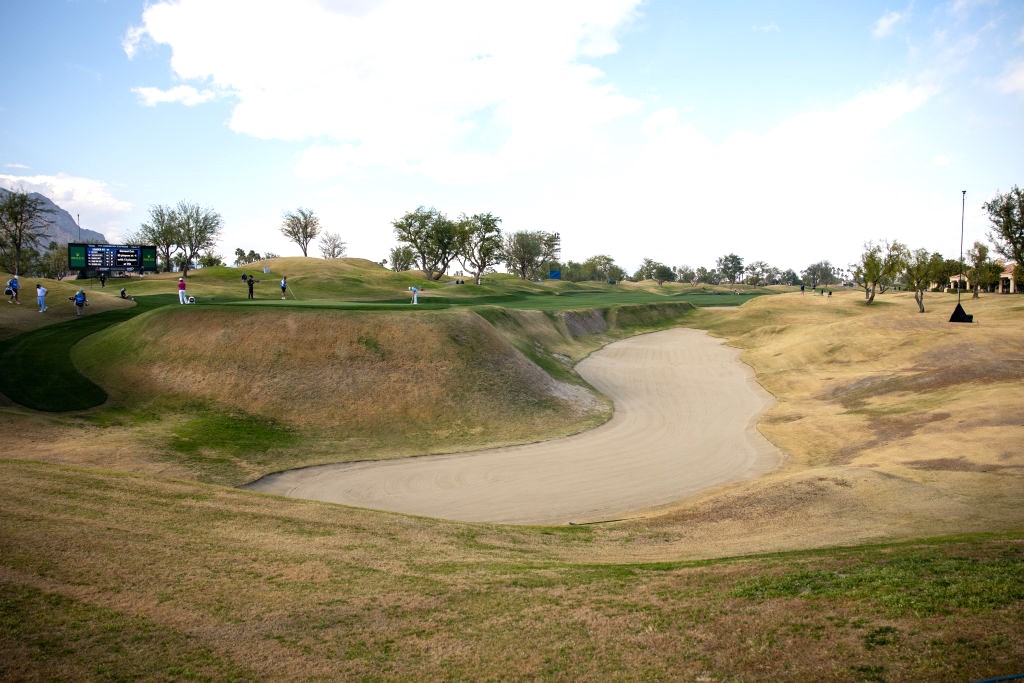
Win chances
The PGA Tour website has win probabilities on it. Currently Burns is 80.7%, Dunlap 16.3%. Dunlap is in the better position after two shots on the 16th. Burns scattered the spectators short of the green; Dunlap is just off the green.
All square with two holes to go
Burns chip was poor one and left him well short of the flag, about 30ft short at a guess and he could not make the birdie putt. But Dunlap made his much shorter birdie putt.
Those win percentages
Are slightly surprising considering that the players are level with two holes to go. Burns is at 66.7%; Dunlap 32.8%.
Burns misses the island green!
Dunlap's shot just hopped on to the front of the green. Burns' 8-iron finds water on the right side. Advantage Dunlap now. Huge advantage.
Burns has left himself a long bogey putt
He had to play from the drop zone, about 100 yards out and he finished inside Dunlap's ball, but neither ball are that near the hole.
Dunlap has a tap-in par
Now, can Burns hole his putt? If he misses, he is two shots behind with one to play.
Burns' putt slides past!
Close but no cigar. Amateur Nick Dunlap has a two-shot lead coming down the last. He'd have taken that at the start of the day. That win probability is now listed at 92.5%.
Wayward drive for Dunlap on 18
He has missed the fairway by a wide margin, but not on the water side. Can't see what his lie is like.
Burns finds water
That's him out of contention. Now Dunlap has to finish ahead of clubhouse leader Christiaan Bezuidenhout who is in on -28 having just birdied the 18th. Dunlap is currently -29. Par needed.
Is the 18th a cape hole?
Well no if you use the historical definition, yes if you use the modern one. A traditional cape hole is one that arcs around water but has the green jutting out into the water, thus the putting surface is surrounded on three sides by water. (Er can you be surrounded on only three sides, maybe that should be ‘flanked on three sides’.) By this definition, the 18th is nor a true cape hole, although some commentators and journalists describe such a design as a cape hole.
Dunlap gets a good break
It looks like his approach is going into the crowd, or a bunker, and he is shouting "fore right!" But the rolls down in the direction of the hole and finds a patch of green grass in a dip not far from the green. An up and down needed to win from 75ft from the hole.
Superb chip!
He leaves himself a very makeable putt. It's of about 6ft. Oh, it's 5ft 9in apparently.
Dunlap holes the putt
Ball goes into the cup dead centre. We have an amateur winner of a PGA Tour tournament for the first time since 1991. He is hugged by his crying mother, and then his father hugs them both at the same time. Nick Dunlap is in tears, too.
What a scene.What a moment. Nick Dunlap celebrates his victory with family and friends.@PGATOURU | @TheAmExGolf pic.twitter.com/dHtsaojlH7January 22, 2024
The winning putt
WOW! 🏆 20-year-old amateur Nick Dunlap is a PGA TOUR champion. He's the youngest amateur to win since 1910. pic.twitter.com/DKQmK0fuAeJanuary 22, 2024
